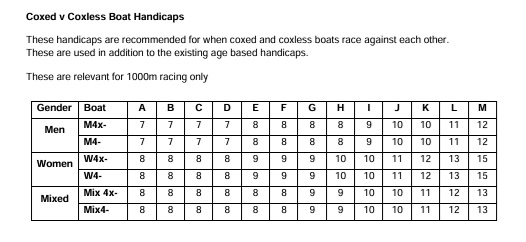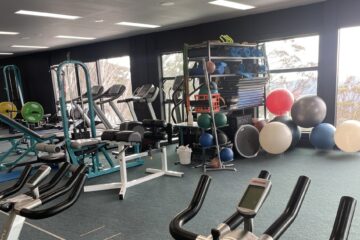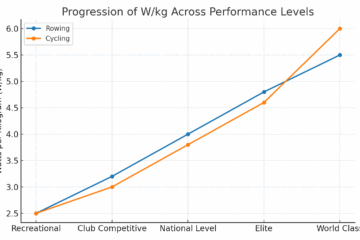In the world of masters and amateur rowing, the question of coxswain weight often sparks lively debate. While elite rowing has strict weight limits, amateur and club-level rowing presents a different scenario. The reality is that in masters rowing, it’s not uncommon to see coxswains who can weigh quite a bit more than the ideal 55kg. Often, rowers even jump in to help as coxswains on race day or in training. This raises an important question: how much extra weight is too much, and how does it really affect boat speed?
To approach this question, I looked at two different methods of analysis. First, I examined the Rowing Australia Handicap System (comparing men’s coxed and coxless quads). For younger masters (age groups A-D), the system suggests that a 10kg overweight coxswain impacts the boat by about 1.272 seconds over 1km. For older masters (age groups E-H), this impact increases slightly to about 1.454 seconds over 1km.
I also considered a theoretical model generated I created using AI, based on fluid dynamics and boat physics. This model suggested that a 10kg overweight coxswain would slow an 8+ crew by approximately 1.05 seconds over 1km. While these time differences might seem significant in elite racing, for amateur masters rowing, they’re relatively small.
It’s important to put these numbers into perspective. In amateur and masters rowing, the benefits of having a coxswain definately outweigh the slight speed disadvantage of extra weight. A dedicated coxswain provides numerous advantages that can more than makeup for a small time difference. For instance, their steering skills can keep the boat on the most efficient course, potentially saving more time than is lost due to extra weight, against coxless crews where a vital crew member is distracted by the role of steering and can not execute the rowing task to their full potential. Moreover, the motivational boost and race strategy input a coxswain provides will nearly always push rowers to perform beyond their usual capabilities.
During training sessions, a coxswain’s role becomes even more crucial. They provide structure, motivation, and technical feedback that can significantly improve a crew’s performance over time. Their ability to observe and provide real-time feedback on technique can lead to efficiency improvements that may well overcome any disadvantage from extra weight.
On race day, the advantages of having a coxswain become even more apparent. Their strategic input can be invaluable, helping the crew to pace themselves effectively and respond to moves from other boats. They act as the eyes and ears of the crew, allowing the rowers to focus entirely on their technique and power output. This focused effort can often result in performance improvements that outweigh the theoretical speed loss from extra weight.
It’s also worth noting that masters races rarely come down to margins as small as one or two seconds. The varying fitness levels, technical abilities, and age handicaps in masters rowing mean that races are often decided by larger margins. In this context, the slight disadvantage of an overweight coxswain becomes even less significant.
While it’s ideal to have a coxswain at the recommended weight, the marginal impact of extra weight shouldn’t discourage participation. In masters and amateur rowing, the value of a good coxswain – regardless of their weight – often surpasses the theoretical speed loss. Their skills, dedication, and contribution to the team spirit might just be the extra push your crew needs to cross the finish line first.
So, the next time you’re debating whether a coxswain is “too heavy,” remember to consider the bigger picture. A slightly heavier coxswain who excels at motivation, strategy, and steering may well be more valuable to your crew than a lighter one who lacks these crucial skills. In the world of masters rowing, it’s often the intangibles that make the difference between a good performance and a great one.
The Handicaps:

The AI model:

Updated Social Media Response:
Following the publication of this post, there has been an overwhelming response via social media, particularly on Reddit. The feedback provides valuable insights into how the rowing community views the issue of coxswain weight. The overwhelming response has been along the lines of “We don’t care how overweight you are, as long as we have you” and “I’ll take an overweight experienced coxswain vs a less experienced one at weight”. This feedback emphasises the value placed on a coxswain’s skills and experience over their weight.
Interestingly, comments have also addressed the “dead weight” concept in the boat. Coxswains, regardless of their weight, are not considered “dead weight” due to the value they add. Instead, the term is often applied to rowers carrying extra weight, which is seen as both “dead weight” and a fitness issue. Some respondents pointed out that in men’s eights, the extra weight of the crew can sometimes outweigh that of a coxswain. This excess weight is not only “dead weight” but also impacts the overall fitness of the boat, creating a double negative effect.
These responses reinforce the main points of the original post while adding nuance to the discussion. They highlight that in the rowing community, especially at the masters and amateur levels, the skills, experience, and positive impact of a coxswain are valued far more than adherence to an ideal weight. This feedback underscores the importance of considering the holistic contribution of a coxswain to a crew’s performance, rather than focusing solely on the potential speed impact of extra weight.



0 Comments